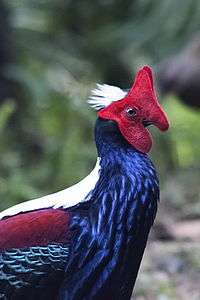Swinhoe's pheasant
| Swinhoe's pheasant | |
|---|---|
 | |
| Scientific classification | |
| Kingdom: | Animalia |
| Phylum: | Chordata |
| Class: | Aves |
| Order: | Galliformes |
| Family: | Phasianidae |
| Subfamily: | Phasianinae |
| Genus: | Lophura |
| Species: | L. swinhoii |
| Binomial name | |
| Lophura swinhoii (Gould, 1863) | |
| Synonyms | |
|
Euplocomus swinhoei | |
Swinhoe's pheasant (Lophura swinhoii), also known as the Taiwan Blue Pheasant, is a bird of the pheasant subfamily in the fowl family Phasianidae. It is endemic to Taiwan. Along with the Mikado pheasant and Taiwan blue magpie, two other Taiwan endemics, the Swinhoe's pheasant is sometimes considered an unofficial national symbol for Taiwan as it bears the colours of the national flag (red, white and blue).
Etymology
The bird was named after the British naturalist Robert Swinhoe, who first described the species in 1862. Other names include Locally, the species is known in Mandarin as lánfùxián (Chinese: 藍腹鷴; literally: "blue-breasted kalij"), and in Taiwanese Hokkien as wa-koe (華雞; hôa-koe; "flowered fowl"; also 畫雞).[2]
Description
The male Swinhoe's pheasant can grow up to 79 cm. He has a glossy blue-purple chest, belly and rump, white nape, red wattles, white tail feathers, and a white crest. The female is brown marked with yellow arrow-shaped spots and complex barring patterns, and has maroon outer rectrices. The juvenile male is dark blue with brown and yellow patterns on its wings. Swinhoe's pheasants can also be distinguished from the Mikado Pheasant by having red legs.



During display, the male's wattles become engorged and he performs a display consisting of a hop followed by running in a circle around females. A frontal display with the tail fanned is occasionally observed. He also does a wing-whirring display like other Lophura pheasants.
Habitat
The Swinhoe's Pheasant is found in the mountains of central Taiwan, where it lives in primary broadleaf forest up to 2,300 meters in elevation.[1]
Behaviour
Swinhoe's pheasant eats seeds, fruits, and some insects and other animal matter. Predators include the crested goshawk as well as civets and badgers.
The female lays a clutch of 2 to 6 eggs which are incubated for 25 to 28 days. The young can leave the nest at 2 to 3 days old. It is often assumed the Swinhoe's pheasant is polygynous, as males are often seen with several females, though information on this assertion is lacking.
Conservation
This pheasant has a small population in a limited range which is shrinking due to habitat degradation. Logging is a problem. It was hunted in the past and some populations were extirpated in the 1960s and 1970s. Today its global population is estimated to be over 10,000 individuals.[1] Some populations are secure within protected areas, but others may be declining. Alongside the Mikado pheasant and Taiwan magpie, they are sometimes unofficially considered national symbols of Taiwan, which has helped in their conservation and protection. In some areas such as Dasyueshan National Forest Recreation Area, they are regularly sighted feeding along roadsides which have become birdwatching hotspots. Often they are fed by bird photographers, which has considered a controversial practice by some conservationists and liable to a fine by park officials.
See also
| Wikimedia Commons has media related to Lophura swinhoii. |
References
- 1 2 3 BirdLife International (2012). "Lophura swinhoii". IUCN Red List of Threatened Species. Version 2013.2. International Union for Conservation of Nature. Retrieved 26 November 2013.
- ↑ Iûⁿ, Ún-giân (2006). "Tai-gi Hôa-gí Sòaⁿ-téng Sû-tián" 台文/華文線頂辭典 [On-line Taiwanese/Mandarin Dictionary] (in Chinese and Min Nan)..
